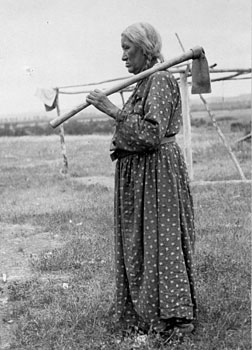
Scattered Corn with Hoe SHSND# D0566American Indians began raising crops in the region now known as North Dakota about 900 years ago. The seeds and the knowledge for cultivating corn, squash, sunflowers, and beans probably came from the Navajo, Hopi, and Pueblo regions of the Southwest. Over time, the varieties of vegetables were adapted to the cold, dry climate of the northern Great Plains. The tribes primarily engaged in horticulture were the Hidatsa and Mandan and somewhat later the Arikara. (Hidatsa, p. 23)
Each woman was assigned a garden plot for her family in the river bottoms along the Missouri or one of its tributaries. Buffalo Bird Woman recalled that the largest garden her family had was 180 yards by 90 yards. Usually a family began with a smaller plot and expanded it for several years. (Buffalo, p. 24) Garden plots were often fenced to prevent animal (deer, bison, horses) depredation.
Corn cultivation began early in the spring when the Goose Society (an adult women’s society) welcomed the corn spirits from the South with a ceremony of song and dance. First the sunflowers were planted, then the corn. (Independence, p. 33)




